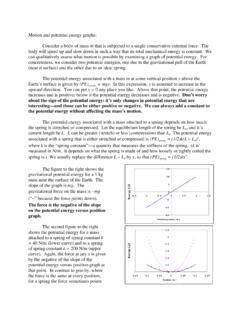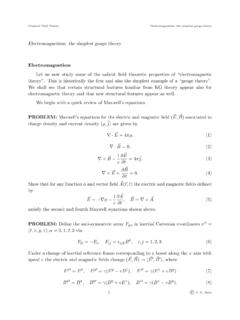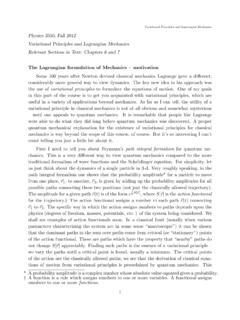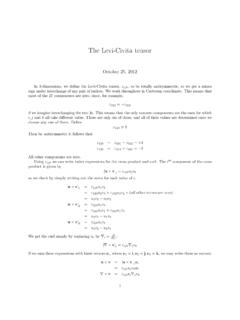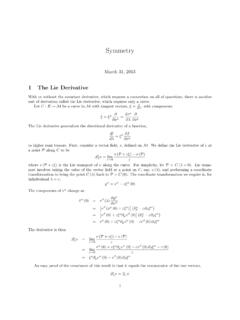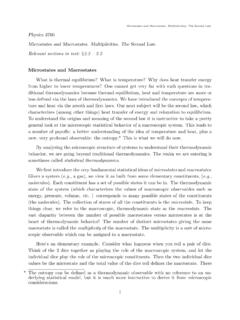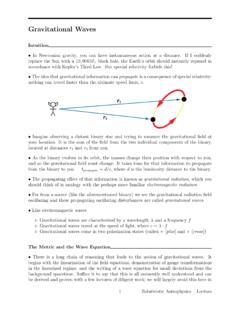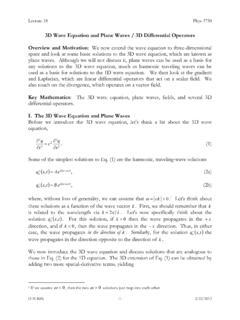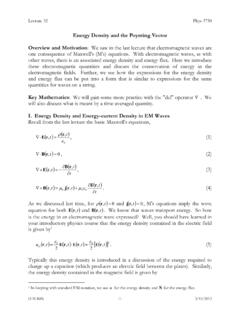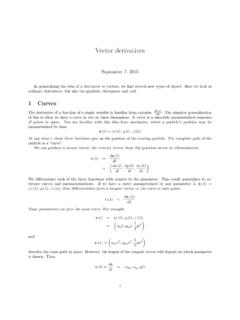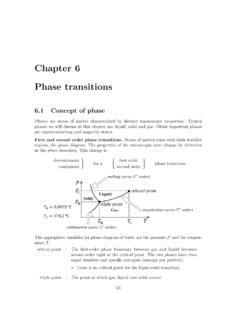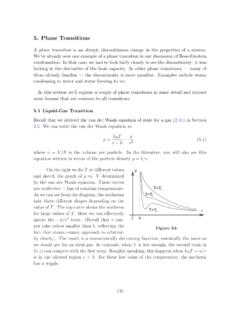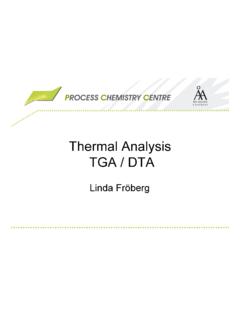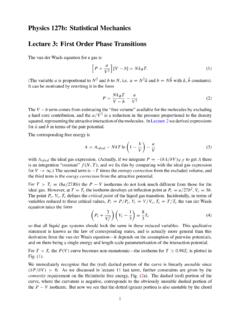Transcription of Helmholtz Free Energy - Home | USU
1 Free Energy . Thermodynamic Identities. Phase 3700 Free Energy . Thermodynamic Identities. Phase sections in text: Free EnergyThus far we have studied two observables which characterize Energy aspects of a is, of course, the internal energyUwhich is just the total Energy of the system. Theinternal Energy is of principal importance because it is conserved; more precisely its changeis controlled by the first law. A second Energy type of quantity is the enthalpyH=U+PVwhich is the Energy needed/yielded upon creation/destruction of the system with volumeVin an environment at a fixed pressureP. ThePVterm represents the work done on/bythe environment. The enthalpy also is the observable whose change corresponds to heattransfer during an isobaric process.*There are other Energy observables which have specialized utility like the enthalpy andcan be analyzed in a similar fashion. Here we introduce two: theHelmholtz free energyand theGibbs free Energy . Just as the enthalpy can be used to characterize heat, the freeenergies can be used to characterize aspects of work.
2 For appropriate processes, the freeenergy observables also have the virtue of serving as a sort of proxy for the entropy withregard to the second law, but foropen systems. Just as the entropy gets maximized forclosed systems by relaxation processes, so the free energies getmiminizedfor appropriatetypes of processes. We begin with the Helmholtz free Helmholtz free Energy is the observableF=U can get an interpretation ofFanalogous to that ofHas follows. Imagine creatinga system in a state with entropySand energyUin equilibrium with an environment atfixed temperatureT. How much Energy must be provided? Some of the energyUcan beobtained as heat from the environment this heat isTS, whereSis the entropy of thecreated system. The rest of the Energy must be provided as work this isF. Conversely,if you destroy the system at constant temperatureTyou need to reduce the entropy tozero via heat transferTSto the environment, the remaining Energy work which can beextracted (for free ) is thenF.
3 You can think ofFas the Energy available to do workfor a system at temperatureT, with energyU, and with entropyS.* WithHas we ve defined it, this statement assumes that only compressional work is doneduring the isobaric process. To maintain the relationship between change in enthalpy andheat when other kinds of work are done, one must generalize the definition ofHto handleother kinds of Energy . Thermodynamic Identities. Phase more practical interpretation ofFcomes when we monitor its change due to anisothermal an isothermal processwe have F= U T the process is also quasi-static, thenT S=Qand we have (using the first law) F= ,Fcan be used to measure the work done in a quasi-static isothermal the observable used to determine work for an isothermal process just asHis used tomeasure heat for an isobaric process. Note that the work in the above formula isallworkof any kind, not just : if the isothermal process is not quasi-static ( ,free expansion), thenT S Q,and we have F all work of any kind done on the system.
4 * Keep in mind that all these deductionsare valid for isothermal are a number of important differential relations involving Helmholtz free Energy ,pressure, entropy, and chemical potential which constitute an alternative form of the ther-modynamic identity. Infinitesimally, we have simply from the definition of the Helmholtzfree Energy dF=dU SdT our original thermodynamic identity built from internal Energy , we get a new formof the thermodynamic identity in terms ofF:dF= PdV SdT+ we haveP= ( F V)T,N,S= ( F T)V,N,and =( F N)T,V.* Including work done by a collapsing/expanding atmosphere in the case where the processis destruction/creation of the Energy . Thermodynamic Identities. Phase , if we expressF=F(V,T,N) we can just take partial derivatives to getP,Sand (expressed as functions of (V,T,N)).Gibbs Free EnergyClosely related to the Helmholtz free Energy is the Gibbs free Energy . This is definedasG=U+PV TS=H TS=F+ upon our interpretations ofHandFyou can probably figure out the correspondinginterpretation ofG.
5 Imagine creating a system from nothing in a state which has volumeV,entropySand is in equilibrium with the environment at temperatureTand the extra Energy which must be supplied beyond that obtainable from the us add up the Energy costs. There is the Energy of the system itself,U. There is thework doneonthe environmentPV, and there is the Energy obtainable via ,Gis the ( free ) Energy you can extract (by destroying the system atconstant temperature and pressure) asnon-compressional workfrom the system takingaccount of the work supplied by the collapsing atmosphere and the heat which must bedumped into the environment to remove the entropy of the , just as the Helmholtz free Energy is designed to give you the total work available ina system with energyUand entropySin equilibrium with an environment at temperatureT. The Gibbs free Energy is designed to give you the non-compressional work availablein a system in equilibrium with an environment at constant temperatureTand , we can interpretGin a more practical way by considering a process occurringat constant pressurePand constant temperatureT.
6 For an isothermal, isobaric processwe have: G= U+P V T a quasi-static process* (withNheld fixed) the first law tells us U=Q P V+Wother,whereWotheris any work besides compressional work. Since (for this quasi-static, isother-mal process)Q=T S,we have G=Wother.* Or for states which can be connected by a quasi-static Energy . Thermodynamic Identities. Phase , for states which can be connected by a quasi-static, isothermal, isobaric process thechange in the Gibbs free Energy represents the non-compressional work states which cannot be connected by a quasi-static process, (but assuming theprocess is isobaric and isothermal) we haveT S Q= G , in this case the change in Gibbs Energy is bounded from above the the withF, there is a version of the thermodynamic identity expressed in terms of theGibbs free Energy . Infinitesimally, we havedG=dU SdT TdS+PdV+V the original thermodynamic identity built from the internal Energy , we havedG= SdT+V dP+ see that we haveV=( G P)T,N,S= ( G T)P,N,and =( G N)T, we expressG=G(T,P,N) we can just take partial derivatives to getV,Sand (expressed as functions of (T,P,N)).
7 Example: Thermodynamics of a batteryThe battery in your car produces Energy via the chemical reactionPb+PbO2+ 4H++ 2SO2 4 2 PbSO4+ that this Energy corresponds to electrical work, so the work is of the non-compressionalvariety. By using the Gibbs free Energy , we are going to see how much electrical work isproduced. This is feasible because (i) the work of interest is non-compressional, (ii) thebattery can be modeled as operating isothermally and we did some time ago with the enthalpy, we can compute the change in the Gibbsfree Energy by taking the difference of the formation values for the initial and final states4 Free Energy . Thermodynamic Identities. Phase the system. These values can be found in tables, as in the back of your text. To do this,we imagine breaking the various initial reactants into their stable constituents and thencombining them to make the final reactants. We have then for each mole (rememberingthe change is final minus initial) G= 2( ) + 2( ) 0 ( ) 4(0) 2( ) = the minus sign we see that the electrical work for this process represents energytransferred to the environment (as it should) and is about 394kJper the process is isobaric and (approximately) isochoric, we have that H= U.
8 *Looking up values for enthalpy in the table we get for the change in internal Energy of thebattery: U= H= 2( ) + 2( ) 0 ( ) 4(0) 2( ) = : the magnitude of Uislessthan the magnitude of G. Somehow the batteryhas actually put out more Energy as electrical work than was available from the chemicalreaction! How did this happen? Well, from the first law we have (for each mole)Q= U W= 316kJ+ 394kJ= , for each mole reacting there is a transfer of 78 kJ via heatfromthe environmentintothesystem, which adds to the Energy output. The battery uses Energy from the environment!When you charge the battery you run this reaction in reverse. To put the battery backinto its initial state you must add 394kJper mole via electrical work. Of this 394kJ,316kJgets stored in the reactants, 78kJgoes into the environment as heat. You mayhave noticed some of this heat when you ve encountered a charging battery that is extensive and have now introduced a lot of thermodynamic observables.
9 Let us list the mostbasic ones:T,P,V,N, ,U,H,S,F, are many formulas involving/relating these quantities, not to mention using theseobservables to define still more observables ( ,heat capacities). When making formulasusing these variables we have to make the units match of course, but there is another* Note that you can t interpret this Has heat transferred since the relation H=Qforisobaric processes requires that the only work is compressional, and here we have Energy . Thermodynamic Identities. Phase constraint on these formulas. This constraint arises because we have intensiveobservables and extensive observables. From the list above, the intensive ones are (T,P, ).The extensive observables are (V,N,U,S,H,F,G). Note that the product of an extensivequantity with an intensive quantity is again extensive. The ratio of extensive quantities isintensive. The sum of two quantities of a given type is of the same type, key newconstraint is that formulas can only equate quantities of the same type.
10 As an example,consider the original thermodynamic identitydU=TdS PdV+ extensive, and each term on the right hand side is the produce of an intensive withan extensive quantity - hence an extensive quantity, as is their sum.* As another example,consider the thermodynamic Energy expressed in terms of the Gibbs free Energy :dG= SdT+V dP+ can easily check the consistency of the intensive/extensive variables shall see next how considerations of extensive versus intensive can lead to usefulnew Energy and chemical potentialKnowing whether an observable is extensive or intensive can be very useful. As animportant example, we know thatGis extensive and we have =( G N)T, formula means that the chemical potential is the change of Gibbs free Energy as youadd a particle holding temperature and pressure fixed. As you add a particleNgoes up,of course. But, sinceG=G(N,T,P) is extensive, and the only extensive variable usedto buildGisN, thenGmust be proportional toN!
